Sabik, designated as Eta Ophiuchi, is the second-brightest star in the constellation of Ophiuchus, the celestial serpent-bearer. It is also a binary star.
Key Facts & Summary
- Sabik is located at around 88 light-years / 27.1 parsecs away from the Sun.
- It is a binary star formed by Eta Ophiuchi A, and Eta Ophiuchi B.
- Eta Ophiuchi A is the primary star, known as Sabik.
- Both Eta Ophiuchi A and B are white A-class main-sequence stars of spectral type A1 IV, with Sabik being slightly larger and more massive than its companion.
- The stellar system has a combined apparent magnitude of 2.43.
- Sabik has an apparent magnitude of 3.05, while its companion is fainter, at 3.27.
- Sabik is more massive than our Sun, having 2.966 solar masses, and its radius is unknown.
- Eta Ophiuchi B is also more massive than our Sun, having 3.478 solar masses.
- Sabik is a relatively fast-spinning star, having a rotational velocity of 23 km / 14.2 mi per second.
- The star system's radial velocity is -0.9 km / 0.5 mi per second.
- Sabik is most likely hotter than our Sun, but its exact temperature is yet unknown. The same applies to its fainter companion.
- Several interesting deep-sky objects are situated in the same area of sky as Sabik, and the star can be used to find them. These objects include the globular cluster Messier 9, and NGC 6356, and even the Box Nebula.
- The constellation of Ophiuchus is the 11th largest in the night sky, and it contains several deep-sky objects and exciting stars.
- The best time to observe Sabik, and the other celestial objects located in Ophiuchus, is during the month of July when the constellation is the most prominent.
- Since Ophichius is visible between latitudes 80oN and -80oS, most people can see it worldwide.
η Ophiuchi
Sabik / Eta Ophiuchi is the second brightest star in the constellation of Ophiuchus, the celestial serpent-bearer, after Rasalhauge / Alpha Ophiuci. Its name comes from the Arabic "al-sabiq" – which translates to "the preceding one."
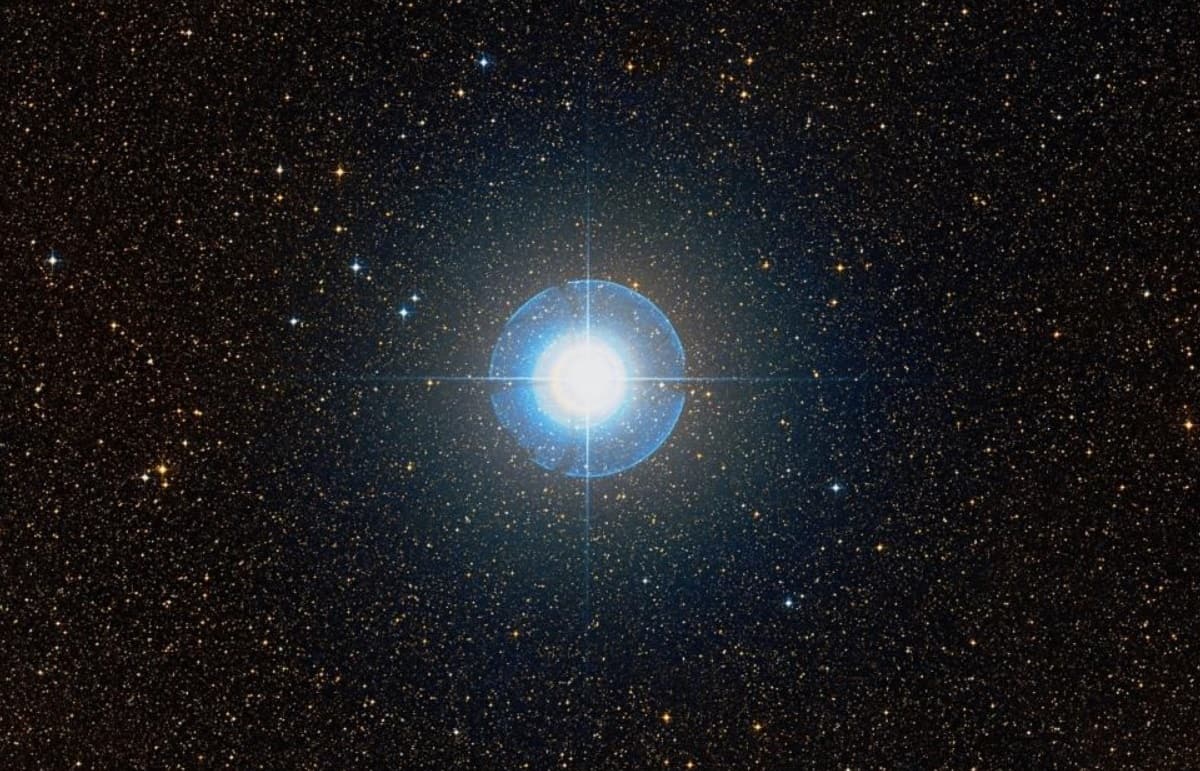
Astronomers are uncertain about why this star was named as such. The IAU officially approved the name Rasalhague for Alpha Ophiuchus in late 2016.
Formation
Eta Ophiuchi was formed several million years ago from an interstellar medium of gas and dust. Gravity pulled the swirling gas and dust together and resulted in the second brightest star of the constellation of Ophiuchus, Sabik. It is unclear if both stars in this stellar system formed at the same time.
Distance, Size, and Mass
Sabik is located at around 88 light-years / 27.1 parsecs away from the Sun. The stellar system has an apparent magnitude of 2.43, and thus it is visible to the naked eye.
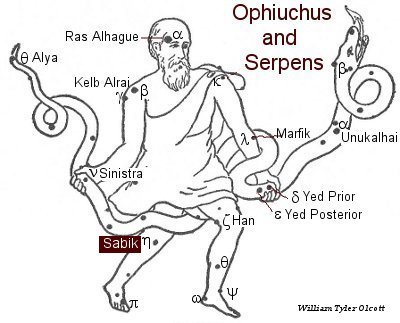
The primary star, designated as Eta Ophiuchi A, has around 2.966 solar masses, or 296% of our Sun's mass, and its radius is unknown. Based on its mass, it clear that both Sabik and its companion are bigger than our Sun.
The secondary star, Eta Ophiuchi B, is more massive than our Sun as well, having 3.478 solar masses, or 347% of our Sun's mass. Its other physical characteristics are currently unknown.
Other Characteristics
Both Sabik and its companion, Eta Ophiuchi B, are white main sequence stars of spectral type A1 IV. Their combined visual magnitude reaches 2.43. If we analyze them separately, Sabik has an apparent magnitude of 3.05, while its companion, Eta Ophiuchi B, is at magnitude 3.27.
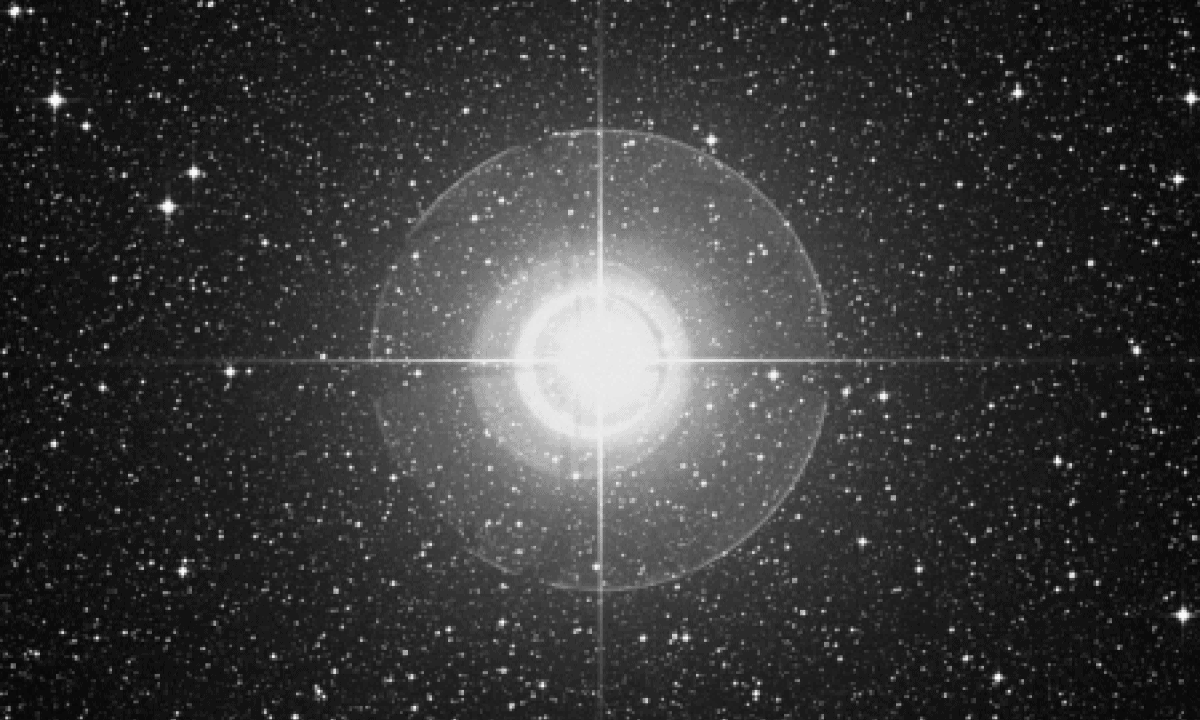
Sabik is a moderately fast-spinning star, having a rotational velocity of 23 km / 14.2 mi per second. The star system's radial velocity is -0.9 km / 0.5 mi per second.
The temperature of Sabik and its companion is unknown; however, it is more than likely that both stars are hotter than our Sun.
Stellar System
The two stars forming the Eta Ophiuchi star system are the white main-sequence stars Eta Ophiucus A / Sabik and its companion Eta Ophiuchi B.
In the Washignton Double Star Catalogue, these stars are designated as WDS J17104-1544A and WDS17104-1544B, while the star system itself is WDS J17104-1544AB.
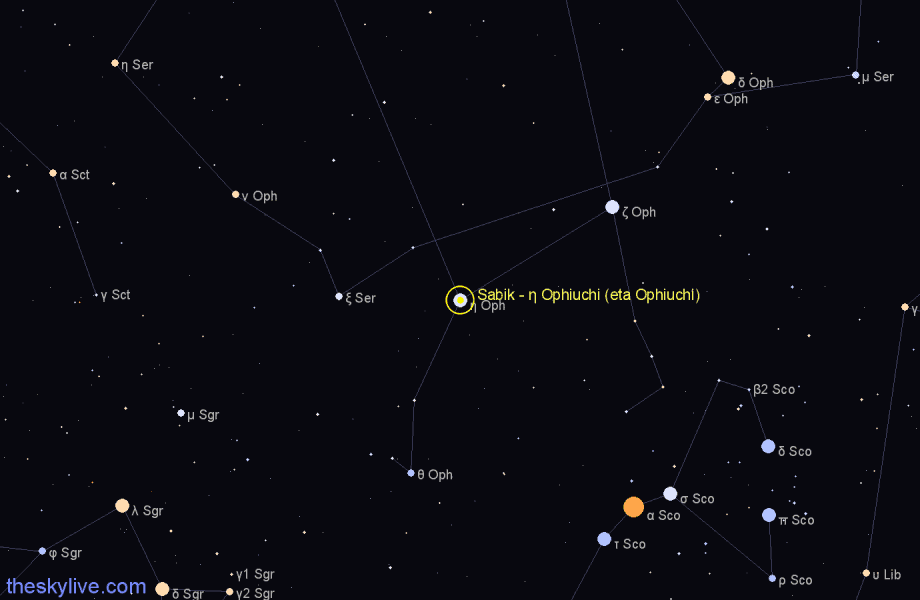
Both stars orbit each other once every 87.58 years, and they have an eccentric orbit of 0.950. Due to this eccentricity, it's most unlikely that any planets could form in this system.
Sabik and Eta Ophiuchi B are separated by only 2 AU – twice the Earth's distance to the Sun. However, their orbit takes them at 65 AU away from one another. The angular size of their orbit is 1.396 arcseconds / 33.5 AU.
Location
Sabik / Eta Ophiuchi is located in the equatorial constellation of Ophiuchus, the celestial serpent-bearer. It is near two prominent southern asterisms, namely the Teapot, and the Fish Hook.
The Teapot asterism is formed by the brightest stars of Saggitarius, while the Fish Hook, from some of the brightest stars in Scorpius. You can find Sabik in the north-northeast of Antares, the brightest star in Scorpius, and west of the imaginary line extended from Kaus Australis, the brightest star in Sagittarius.
Sabik is the second-brightest star in this constellation, and together with Rasalhague / Alpha Ophiuchi, are the only navigational stars of this constellation.
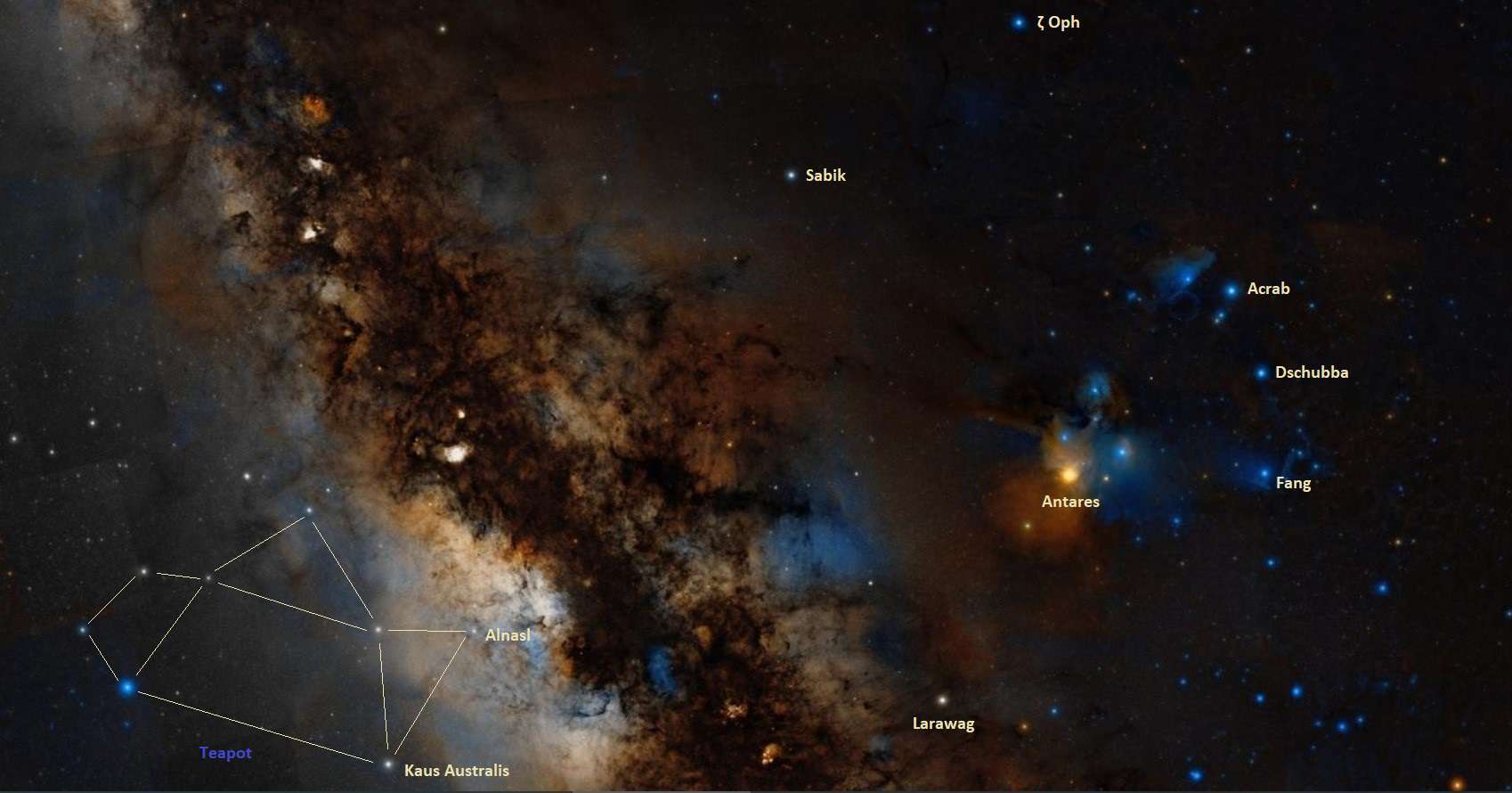
If you want to find Rasalhague, it is located halfway between Vega (constellation of Lyra) and Antares (constellation of Scorpius).
Sabik can be used to find several interesting deep-sky objects, such as the globular cluster Messier 9, which is located at 3 degrees southeast of Sabik. The globular cluster NGC 6356 is at only 80' northeast of Messier 9, while the Box Nebula / NGC 6309 is less than 3 degrees north and a little east of Sabik.
Ophiuchus's constellation is also known as Serpentarius, and it represents the mythical Greek healer known as Asclepius. He is usually depicted as holding a giant snake represented by the nearby constellation of Serpens.
Ophiuchus is among the first 48 Greek constellations listed by Claudius Ptolemy in his 2nd century Almagest. Ophiuchus is the 11th largest constellation out of the 88 modern constellations.
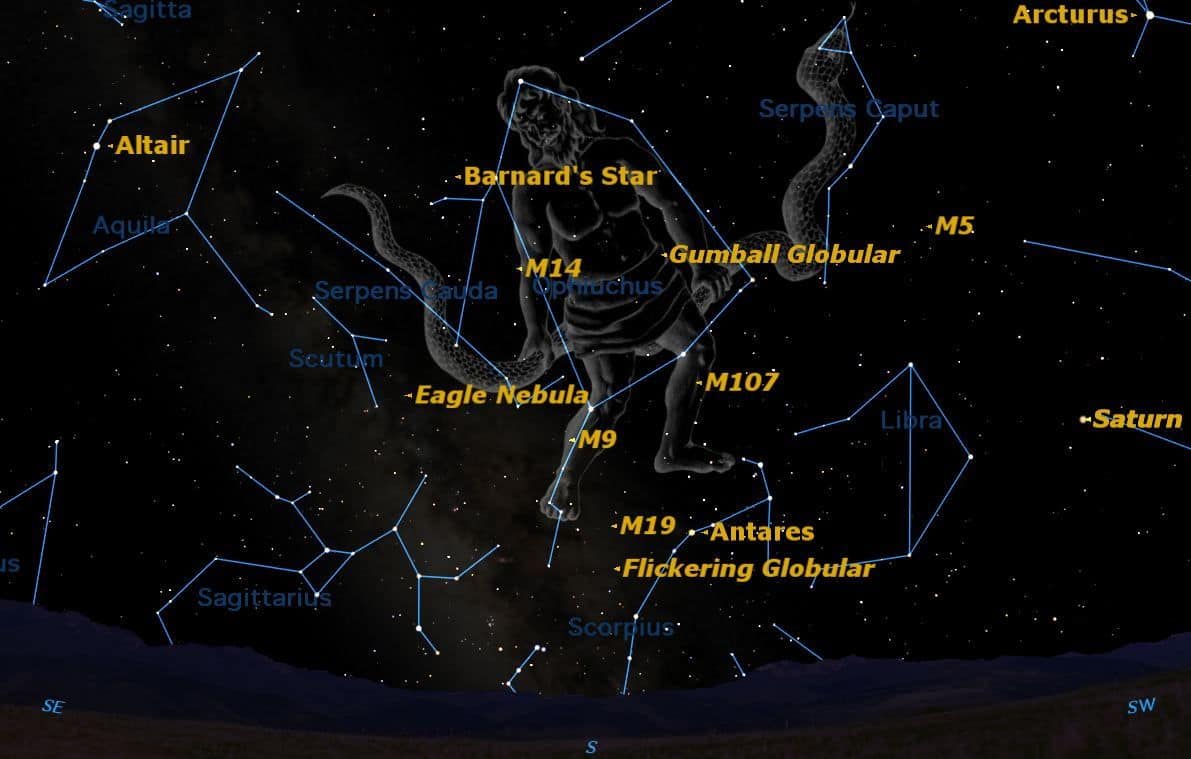
Some interesting Messier objects and deep-sky objects in Ophiuchus are the globular clusters Messier 9, Messier 10, Messier 12, Messier 14, Messier 19, Messier 62, and Messier 107. Their magnitudes vary from 6.42 to 8.85.
Barnard's Star, one of the closest to Earth, RS Ophiuchi, a recurrent nova, Kepler's Supernova, Monkowsky's Butterfly, or the famous Dark Horse Nebula are also located in the constellation of Ophiuchus.
Ophiuchus can be seen from almost anywhere on Earth, and the best time to observe the constellation, Sabik, and other bright stars and deep-sky objects, is during the month of July.
The ten brightest stars in the constellation of Ophiuchus are:
- Rasalhague / Alpha Ophiuchi – magnitude 2.07
- Sabik / Eta Ophiuchi – magnitude 2.43
- Zeta Ophiuchi – magnitude 2.569
- Yed Prior / Delta Ophiuchi – magnitude 2.75
- Cebalrai / Beta Ophiuchi – magnitude 2.75
- Kappa Ophiuchi – magnitude 3.20
- Yed Posterior / Epsilon Ophiuchi – magnitude 3.22
- Theta Ophiuchi – magnitude 3.26
- Nu Ophiuchi – magnitude 3.332
- 72 Ophiuchi – magnitude 3.73
Did you Know?
- Sabik is part of the 58 bright stars selected for celestial navigation. It is one of the two stars in Ophiuchus which are part of this particular group of stars, the other one being Rasalhague / Alpha Ophiuchus, which is brighter.
- Both Rasalhague / Alpha Ophiuchus and Sabik / Eta Ophiuchus are part of another group of 13 stars which are known as the navigational stars of the western hemisphere.
- The other navigational stars of the western hemisphere are Antares (Scorpius constellation), Gienah (Corvus constellation), Nunki (Sagittarius constellation, Alpheratz (Andromeda constellation), Enif and Markab (Pegasus constellation), Altair (Aquila constellation), Alphecca (Corona Borealis constellation), Spica (Virgo constellation), Zubenelgenubi (Libra constellation), and Arcturus (Bootes constellation).
- Sabik is part of the Chinese asterism "Tian Shi Zuo Yuan" – the Left Wall of Heavenly Market Enclosure – which represents eleven old states in China.
- Sabik is known to the Chinese as "Tian Shi Zuo Yuan shiyi" – the Eleventh Star of Left Wall of Heavenly Market Enclosure, representing the state of Song.
Sources:
Image Sources:
- https://www.star-facts.com/wp-content/uploads/2020/09/Sabik.jpg?189db0&189db0
- https://www.constellationsofwords.com/images/stars/Sabik.JPG
- https://in-the-sky.org/image.php?style=hugeteaser&userimg=19910715_115935_be3e1457d4a1.png
- https://theskylive.com/sky/stars/finder-charts/sabik-eta-ophiuchi-finder-chart.png?c=1586791646’
- https://www.star-facts.com/wp-content/uploads/2020/09/Sabik-location.jpg?189db0&189db0
- https://cdn.mos.cms.futurecdn.net/NV6kwnXYNR6w9GHZspGnNL-1200-80.jpg
